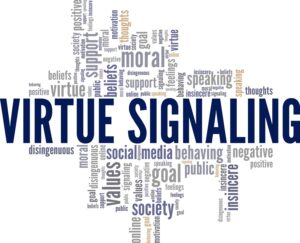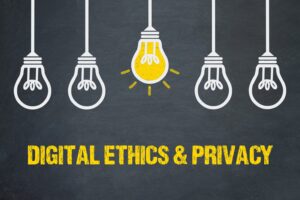
Virtue Signaling
Virtue signaling is a term that is often used pejoratively to describe the public expression of opinions or sentiments intended to demonstrate one’s good character or social conscience or the moral correctness of one’s position on a particular issue. Virtue signaling is often used to imply that the person expressing such opinions or sentiments is doing so insincerely or hypocritically, without actually being committed to the cause or issue they claim to support. Virtue signaling is also seen as a form of self-glorification or self-righteousness, rather than a genuine expression of moral concern or conviction. Virtue signaling is often associated with social media platforms, where people can easily share their views on various topics and receive validation or criticism from others. Some examples of virtue signaling are: expressing outrage over a social injustice without taking any concrete action to address it; posting a picture of oneself with a marginalized group or a charitable cause without having any meaningful involvement with them; displaying symbols or slogans that indicate one’s alignment with a certain political or ideological movement without understanding its implications or consequences.
The main difference between virtue ethics and virtue signaling is that virtue ethics is a normative ethical theory that aims to provide guidance for how to live a good life and cultivate moral character, while virtue signaling is a descriptive term that criticizes the superficial or self-serving display of moral attitudes or opinions. Virtue ethics is concerned with the internal qualities of the agent, such as their motives, intentions, emotions, and reasoning, while virtue signaling is concerned with the external appearance of the agent, such as their words, actions, and symbols. Virtue ethics requires consistent practice and habituation of virtues, while virtue signaling does not require any effort or sacrifice on the part of the agent. Virtue ethics values practical wisdom and contextual sensitivity, while virtue signaling disregards the complexity and diversity of moral situations. In short, virtue ethics is about being virtuous, while virtue signaling is about appearing virtuous.
Greenwashing is a form of advertising or marketing spin in which green PR and green marketing are deceptively used to persuade the public that an organization’s products, aims and policies are environmentally friendly or have a greater positive environmental impact than they actually do. Greenwashing involves making an unsubstantiated claim to deceive consumers into believing that a company’s products are environmentally friendly or have a greater positive environmental impact than they actually do. Greenwashing may also occur when a company attempts to emphasize sustainable aspects of a product to overshadow the company’s involvement in environmentally damaging practices. Greenwashing is a play on the term “whitewashing,” which means using false information (misinformation) to intentionally hide wrongdoing, error, or an unpleasant situation in an attempt to make it seem less bad than it is.
Greenwashing is an example of virtue signalling, which is the public expression of opinions or sentiments intended to demonstrate one’s good character or social conscience or the moral correctness of one’s position on a particular issue. Virtue signalling is often used to imply that the person expressing such opinions or sentiments is doing so insincerely or hypocritically, without actually being committed to the cause or issue they claim to support. Virtue signalling is also seen as a form of self-glorification or self-righteousness, rather than a genuine expression of moral concern or conviction.
Greenwashing can be used by individuals, companies and governments to appear more virtuous than they actually are, and to gain favour with consumers, investors, voters or other stakeholders who are concerned about environmental issues. However, greenwashing can be seen as a dishonest and manipulative practice that undermines the credibility and trustworthiness of the entity and its products, services or policies. Greenwashing can also have negative consequences for the environment and society, as it may mislead people into buying products that are harmful or wasteful, investing in companies that are polluting or exploiting, supporting policies that are ineffective or detrimental, or discouraging them from taking more effective actions to reduce their environmental impact. Greenwashing can also create confusion and skepticism among people about the genuine environmental claims and initiatives of other entities. Some examples of greenwashing by individuals, companies and governments are:
Individuals: Some people may engage in greenwashing by buying products that have green labels or packaging, but are not actually eco-friendly. They may also post pictures or messages on social media that show their support for environmental causes, but do not reflect their actual lifestyle choices or actions.
Companies: Some companies may engage in greenwashing by renaming, rebranding or repackaging their products to make them seem more natural, organic or sustainable. They may also launch PR campaigns or commercials that portray them as eco-friendly or socially responsible, but do not match their actual practices or performance.
Governments: Some governments may engage in greenwashing by announcing policies or initiatives that claim to address environmental issues, but are either insufficient, ineffective or counterproductive, such as HSBC’s climate ads or Ikea’s illegal logging. They may also use green rhetoric or symbols to appeal to voters or other countries, but do not follow through with concrete actions or commitments.
Greenwashing involves making false or exaggerated claims about the environmental friendliness or impact of an entity or its products, services or policies. It is a deceptive and unethical practice that can harm both the environment and the people who are misled by it.
Are you a technical, business or legal professional who works with technology adoption? Do you want to learn how to apply ethical frameworks and principles to your technology work and decision-making, understand the legal implications and challenges of new technologies and old laws, and navigate the complex and dynamic environment of technology innovation and regulation? If so, you need to check out this new book: Ethics, Law and Technology: Navigating Technology Adoption Challenges. This book is a practical guide for professionals who want to learn from the experts and stay updated in this fast-changing and exciting field.


